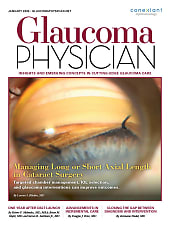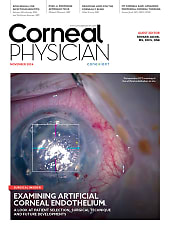A 72-year-old caucasian male with a history of hypertension, pre-diabetes, coronary artery disease, motor neuron disease, and mycosis fungoides presented with a 2-month history of decreased vision and floaters affecting his left eye.
HISTORY + EXAM
On review of systems, he reported having a skin lesion with purulent discharge on his abdomen for a few weeks (Figure 1). His ocular history was unremarkable. Visual acuity was 20/30 in the right eye and 20/50 in the symptomatic eye. Intraocular pressures were 17 and 20 in the right and left eye, respectively, and no afferent pupillary defect was noted.

Anterior segment examination was remarkable for 2+ nuclear sclerotic cataracts in both eyes and showed no anterior chamber inflammation. Dilated examination revealed 2+ vitreous cells, 1+ vitreous haze, and some peripheral retinal pigment epithelium (RPE) changes in the right eye (Figure 2A) and 2+ vitreous cells, 2+ vitreous haze, and some peripheral RPE changes in the left eye (Figure 2B). There was no retinitis or other retinal or choroidal lesions in either eye.

Ocular coherence tomography was flat without abnormalities in both eyes. Fluorescein angiogram of both eyes showed mild disc staining, but did not show any vascular leakage or presence of retinal or choroidal lesions (Figure 3A-B).

At this point our differential was broad and included infection, inflammation, and malignancy. A workup was ordered and close follow-up was scheduled. The patient was referred to his dermatologist for treatment of his skin lesions.
The laboratory workup for infectious and autoimmune etiologies was negative and included negative blood cultures, FTA-ABS, and QuantiFERON-TB Gold Plus. His ocular examination remained unchanged, but because of the high clinical suspicion for lymphoma vs. an infectious process (less likely), the patient underwent a diagnostic vitrectomy and the vitreous sample was sent for gram stain, aerobic and anaerobic cultures, fungal smear, fungal culture, cytology, as well as flow cytometry.
DIAGNOSIS + TREATMENT
Flow cytometry showed “monoclonal T cell population,” giving us a final diagnosis of “cutaneous T-cell lymphoma (mycosis fungoides) with intraocular involvement by T-cell lymphoma.”
Patient was referred to general oncology and ocular oncology for evaluation and management. Plan was for him to start either intravitreal methotrexate or external beam radiotherapy.
DISCUSSION
The evaluation of a patient presenting with vitreous inflammation requires a great deal of attention to detail. The goal is to obtain a comprehensive history and review of systems that can guide us on the right path and help us formulate a good differential diagnosis and management plan.
In these patients, a good dilated fundus examination is key to rule out the presence of chorioretinal lesions, more specifically any retinitis that could indicate an infection possibly caused by a virus, fungus, or toxoplasmosis.
Details such as recent hospitalizations, presence of catheters, intravenous drug use, or concurrent infections should make us suspicious of an endogenous infectious process. Advanced age and lack of other inflammatory signs would increase our concern for a primary malignancy such as vitreoretinal lymphoma.
A history of skin melanoma or other extraocular malignancy should make us concerned of metastatic vitreous involvement. Also, any patient presenting with inflammation or findings that mimic inflammation, must have syphilis, sarcoidosis, and tuberculosis ruled out.
In many of these cases, a diagnostic vitrectomy becomes mandatory to get to the final diagnosis, prevent further vision loss, and even improve patient survival. The timing of the vitrectomy depends on the progression of the disease and the risk for permanent vision loss with a delayed diagnosis.
Once a decision to perform a diagnostic vitrectomy is made, the treating physician must communicate with an experienced pathologist and coordinate how to handle and transport the sample to increase the diagnostic yield. If an experienced pathologist is not found, it might be better for the patient to be referred to another institution where an ocular pathologist is available.
In this interesting case, the vitreous biopsy was reviewed by an expert ocular pathologist and the rare diagnosis of vitreous involvement from his primary cutaneous T-cell lymphoma was made.
Mycosis fungoides, the most common cutaneous T-cell lymphoma, is a low-grade cutaneous lymphoma. It is notable for highly symptomatic progressive skin lesions, including patches, plaques, tumors, and erythroderma, and has a poorer prognosis at later stages.1
Mycosis fungoides with vitreous involvement is rare and can have a similar presentation to primary intraocular lymphoma. Prognosis is poor despite treatment.2 NRP
REFERENCES:
- Galper SL, Smith BD, Wilson LD. Diagnosis and management of mycosis fungoides. Oncology (Williston Park). 2010;24(6):491-501.
- Wan MJ, Sheidow TG, Jones GW, Heathcote JG. Vitritis as the initial manifestation of recurrent mycosis fungoides. Retin Cases Brief Rep. 2009;3(3):240-242.








